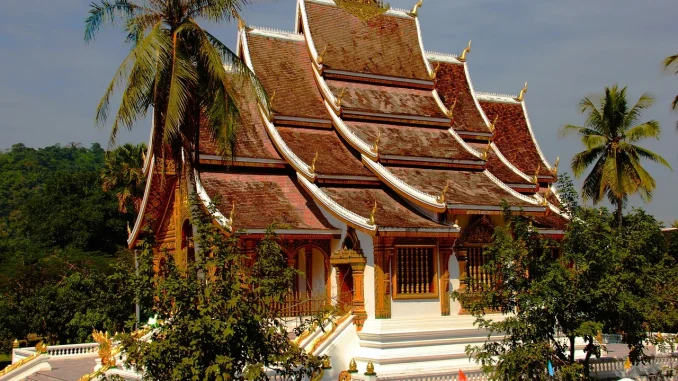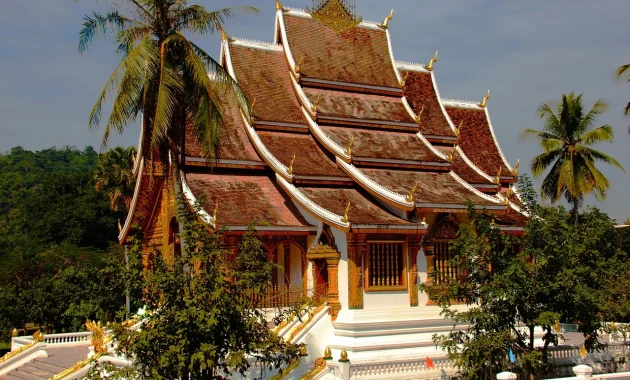
Temples of Vientiane
Wat Si Saket
Wat Si Saket is one of the oldest temples in Vientiane, dating back to 1818. This temple is renowned for its remarkable architecture, featuring a five-tiered roof and a cloister wall housing over 2,000 ceramic and silver Buddha images. It’s a peaceful retreat that offers a glimpse into the religious life of the Laotian people. The temple’s historical significance is also notable, as it survived the Siamese invasion in the 19th century, making it a symbol of resilience and faith.
Pha That Luang
Pha That Luang, or the Great Stupa, is the most important national monument in Laos and a symbol of Buddhist religion and Lao sovereignty. Originally built in the 3rd century, the stupa has undergone several reconstructions, the most recent in the 16th century by King Setthathirat. Its golden exterior, representing the splendor of Laos, is a sight to behold. The stupa is surrounded by a complex of smaller temples, each contributing to the site’s profound spiritual atmosphere.
Wat Ho Phra Keo
Wat Ho Phra Keo, also known as the Temple of the Emerald Buddha, was originally constructed in 1565 to house the Emerald Buddha. Although the statue was later taken to Thailand, the temple remains a significant cultural and historical site. The temple is now a museum showcasing Lao religious art and artifacts, providing insight into the country’s spiritual heritage.
Museums in Vientiane
Lao National Museum
The Lao National Museum offers a comprehensive overview of the country’s history, from prehistoric times to the present day. The museum’s exhibits include archaeological finds, traditional costumes, and relics from the colonial and revolutionary periods. It’s an essential stop for anyone looking to understand the historical context of Laos.
COPE Visitor Centre
The COPE Visitor Centre is dedicated to educating visitors about the impact of unexploded ordnance (UXO) in Laos and the efforts to provide rehabilitation services to those affected. The exhibits are both informative and moving, highlighting the ongoing challenges and the resilience of the Lao people.
Kaysone Phomvihane Museum
This museum is dedicated to the life and legacy of Kaysone Phomvihane, the first leader of the Lao People’s Revolutionary Party. The museum’s exhibits include personal artifacts, photographs, and documents, offering a deep dive into the country’s modern history and its revolutionary past.
Vientiane’s Vibrant Markets
Talat Sao (Morning Market)
Talat Sao, or the Morning Market, is a bustling hub where locals and tourists alike can find everything from fresh produce to electronics. The market is a great place to experience the daily life of Vientiane’s residents and sample some delicious street food. Key attractions include stalls selling traditional Lao textiles, handicrafts, and jewelry.
Vientiane Night Market
Located along the Mekong River, the Vientiane Night Market comes alive in the evening with rows of red-roofed stalls. Here, you can find a wide variety of goods, including clothing, accessories, and souvenirs. It’s also a fantastic place to try local snacks and enjoy the vibrant atmosphere.
O’Fallon Market
O’Fallon Market is less touristy but equally charming. This market offers an authentic experience of Vientiane’s local trade, with vendors selling fresh produce, meats, and household items. It’s a great place to explore if you’re looking for a more off-the-beaten-path market experience.
Traditional Arts and Crafts
Traditional arts and crafts play a significant role in Lao culture, showcasing the skill and creativity of local artisans.
Silk Weaving
Silk weaving is a centuries-old tradition in Laos, known for its intricate patterns and vibrant colors. Visiting weaving villages or local markets where these beautiful textiles are sold is a must. Carol Cassidy’s Lao Textiles is a well-known place to witness and purchase exquisite handwoven silk.

Wood Carving
Wood carving is another prominent craft in Laos, often seen in temples and traditional homes. The detailed carvings depict various aspects of Lao mythology and everyday life. You can find beautiful wood carvings at markets and specialized craft shops in Vientiane.
Cultural Festivals in Vientiane
Boun That Luang
Boun That Luang is the most significant Buddhist festival in Laos, held at Pha That Luang in November. The festival includes religious ceremonies, parades, and a fair with traditional music, dance, and food.
Lao New Year (Pi Mai)
Lao New Year, or Pi Mai, is celebrated in April with three days of festivities. The celebrations include water fights, religious ceremonies, and cultural performances, reflecting the joyous spirit of the Lao people.
Boun Bang Fai (Rocket Festival)
Boun Bang Fai, or the Rocket Festival, is held in May to encourage the coming of the rains. The festival features homemade rockets launched into the sky, accompanied by music, dance, and traditional games.
Culinary Heritage
Lao cuisine is an integral part of the cultural experience in Vientiane. The city’s food scene offers a delightful mix of flavors influenced by its history and geography.
Must-Try Traditional Dishes
Some must-try dishes include Laap (a spicy meat salad), Tam Mak Hoong (papaya salad), and Khao Piak Sen (rice noodle soup). These dishes reflect the bold flavors and fresh ingredients characteristic of Lao cuisine.
Historic Landmarks
Patuxai (Victory Gate)
Patuxai, also known as the Victory Gate, is a war monument dedicated to those who fought for Laos’ independence from France. Its design is reminiscent of the Arc de Triomphe in Paris, but with traditional Lao motifs. The monument offers a panoramic view of Vientiane from its top.
That Dam (Black Stupa)
That Dam, or the Black Stupa, is a legendary monument believed to be the home of a seven-headed naga (mythical serpent) that protected Vientiane from invasion. The stupa’s mysterious and weathered appearance adds to its allure.
Modern Vientiane
Vientiane is a city where tradition and modernity coexist. While the city’s cultural heritage is preserved in its temples, museums, and markets, contemporary influences are visible in its emerging cafes, restaurants, and art spaces.
Practical Tips for Visiting
- Best Time to Visit: The best time to visit Vientiane is during the cool and dry season from November to February.
- Transportation: Tuk-tuks and bicycles are popular modes of transport for exploring the city.
- Accommodation: From luxury hotels to budget guesthouses, Vientiane offers a range of accommodation options to suit all preferences and budgets.